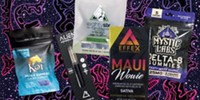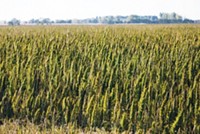Advertisement
Grab your lab coat. Let's get started
Welcome!
Welcome!
Create an account below to get 6 C&EN articles per month, receive newsletters and more - all free.
It seems this is your first time logging in online. Please enter the following information to continue.
As an ACS member you automatically get access to this site. All we need is few more details to create your reading experience.
Not you? Sign in with a different account.
Not you? Sign in with a different account.
ERROR 1
ERROR 1
ERROR 2
ERROR 2
ERROR 2
ERROR 2
ERROR 2
Password and Confirm password must match.
If you have an ACS member number, please enter it here so we can link this account to your membership. (optional)
ERROR 2
ACS values your privacy. By submitting your information, you are gaining access to C&EN and subscribing to our weekly newsletter. We use the information you provide to make your reading experience better, and we will never sell your data to third party members.
Global Health
Afghanistan’s crystal meth boom is rooted in this plant
A shift to making the illicit drug from ephedra has caused output to soar
by Lynzy Billing, special to C&EN
April 11, 2021
| A version of this story appeared in
Volume 99, Issue 13

In a quiet building at the back of a government compound in the north of Kabul, Afghanistan’s capital, Khalid Nabizada sits at his desk. Behind him are four screens, each showing a room packed from floor to ceiling with crystal methamphetamine—just a small portion of the amount seized by Afghan police in drug busts in 2020.
Nabizada has been head of the Counter Narcotics Police of Afghanistan (CNPA) forensic laboratory for 17 years, processing more than 60,000 drug samples. These days, methamphetamine takes up most of his time. It’s the fastest-growing illicit drug in Afghanistan, he says. And while demand is high, the price is dropping.
“International buyers know it can be made easily and cheaply here, the chemicals used are not controlled, and this ephedra plant is everywhere,” he says, turning a wiry, green branch in his fingers.
Ephedra—known as oman in some areas of the country and bandak in others—has grown wild and abundantly across Afghanistan’s mountainous central highlands for centuries. Today, the plant is behind the dramatic growth in the methamphetamine industry in Afghanistan.
Around the world, most meth is made from synthetic ephedrine, a decongestant found in cough and cold products. And before 2017, producers in Afghanistan opted for this precursor as well, Nabizada says. They usually obtained ephedrine, or the related chemical pseudoephedrine, from store-bought medications. But sourcing enough to support meth production is slow and expensive.
So in 2015, Afghanistan’s producers began experimenting with extracting ephedrine from the ephedra plant, and by 2018, most local meth labs were using the plant. The switch sparked rapid growth in the industry and a corresponding surge in profits that are making their way to the coffers of the Taliban.
Data from the United Nations Office on Drugs and Crime (UNODC) suggest that Afghanistan has in a short period become a producer and supplier of relatively large quantities of low-cost ephedrine and methamphetamine. The unregulated output has the potential to rival the value of the country’s infamous levels of poppy-derived opiates.
A growing number of methamphetamine manufacturing facilities operate across Afghanistan, in western Farah and Herat, as well as Nimroz Province, which borders Iran—areas, Nabizada says, that are not fully under government control. The starting materials are easy to get: the ephedra plant is legal in Afghanistan, and other chemicals used in meth production, including iodine, red phosphorus, and sulfuric acid, are also unregulated and widely available in the country.
Illicit-drug makers in Afghanistan recognized the potential to use the ephedra plant in meth production over a decade ago. David Mansfield, an independent consultant who has been researching Afghanistan’s synthetic drug production for the past 25 years, says that Iran and China are possible points of origin for the know-how of extracting ephedrine from the plant. One theory, noted by a 2020 article in the digital magazine Undark, is that Iranian meth producers passed their knowledge to Afghan counterparts in the mid-2010s to skirt an Iranian crackdown.
In Afghanistan, meth producers often conduct ephedra-based meth production in simple mud huts with limited resources and equipment. Aside from the key ingredient of ephedrine or pseudoephedrine, meth production requires only a handful of common chemicals, some simple kitchen glassware, and a gas burner.
Transitioning from over-the-counter medicines to ephedrine isolated from the ephedra plant has advantages: plant extraction is cheaper and requires little chemical knowledge. Still, ephedra is a limited natural resource collected only in the summer, unless cultivated on purpose in fields, Mansfield says.
And extraction requires a large amount of the plant and a regular supply. Depending on the quality of the ephedra plant, between 115 and 270 kg are required to produce 1 kg of ephedrine, which in turn yields about two-thirds of a kilogram of methamphetamine.
But Afghanistan’s ephedra-based meth production would not be possible without the lack of meaningful constraints on illicit drug production in the country. “There are few places where such large-scale harvesting, transport, processing, and cross-border trade would be possible other than Afghanistan,” Mansfield says.
The absence of the risk of detection and interdiction translates into lower costs. Afghanistan produces meth at a tenth of the price of production in Southeast Asia but at comparable quality, according to forensic tests in Australia, Mansfield says. “This gives Afghanistan a competitive edge in global illicit drug markets.”

Currently, ephedra is harvested in at least eight Afghan provinces, dried in the central highlands, and then sold to labs in the south and southwest where ephedrine and meth are produced. Mansfield found 329 ephedrine labs in the district of Bakwa in Farah Province alone.
The dried ephedra is ground into a flour that is soaked in a mixture of water, gasoline, salt, and caustic soda for 24 h. Reports by Mansfield and the European Union describe how this solution is then filtered and transferred into a metal tank. The next stage involves heating with salt, sulfuric acid, and xylene, creating a residue with the appearance of dried yogurt. This is ephedrine, which can be sold or converted into meth through a reaction with iodine and other chemicals, the reports say.
This plant-based production has contributed significantly to the local economy. For example, Bakwa District’s thriving cottage industry in ephedrine and meth might be worth up to $240 million a year, Mansfield says. It provides seasonal employment for almost 20,000 people, 5,000 of whom are employed in meth labs, and contributes the equivalent of around $55 million a year in local wages.
Yet the switch to the cheap and accessible ephedra plant is having public health repercussions for Afghanistan as well. Martin Raithelhuber, a synthetic drug expert with the UNODC, sees evidence that people in the country who use opiates are also using meth. “There is a risk that a dual health crisis develops in Afghanistan, with methamphetamine adding to the already-existing opiate problem, while drug treatment facilities are not available everywhere and are geared towards treating opiate dependence,” he says.
With decades of experience processing and transporting heroin, the Taliban controls virtually all Afghan drug distribution networks. The group has become increasingly reliant on the production of ephedrine and meth as a source of income and earns up to $4.2 million per year in taxes, according to Mansfield. Nabizada says the shift to meth may have been triggered by the 2018 drought in Afghanistan, in which large tracts of opium crops were destroyed.
Data shortfalls make it difficult to establish the true size and nature of Afghanistan’s meth problem. A November 2020 report funded by the European Union shows that Afghanistan is beginning to penetrate international markets through well-established heroin-trafficking routes as well as new ones.
“Seizures have been doubling year on year since the first recorded seizure of 2 g in May 2009,” Nabizada says, referring to actions by the CNPA in Afghanistan. Between January and October 2020, the agency seized 937.2 kg.
Since 2018, Afghan meth has been seized in the Persian Gulf and as far afield as Africa and Australia, Mansfield says. Iran’s meth seizures on the Afghan border have more than doubled in the past 12 months.
In 2020, over 3,000 kg of meth with Afghan markings was seized from boats off Pakistan’s Makran coast. Chemical testing in Mozambique and Australia shows the meth was produced from the ephedra plant and is likely from Afghanistan, according to Mansfield. An 821 kg seizure in Indonesia and a 600 kg seizure in Sri Lanka in 2020 showed the same markings.
“There is little evidence that the meth trade in Afghanistan feels under threat,” Mansfield says. “It thrives in the open.” Meanwhile, law enforcement efforts, including a 2017 aerial bombing campaign by US and Afghan military forces that targeted drug labs, have been largely ineffectual and short lived.
If the industry has a problem, it is falling prices, Mansfield says; the low prices are possibly a function of overproduction. The wholesale price fell by more than 50% between March 2019 and June 2020, to around $280 per kilogram, Mansfield says; the price compares favorably with prices in places like China, eastern Europe, and Mexico. If this trend of low prices and easily sourced ephedra continues, Afghanistan could soon play a significant role in the global synthetic drug trade.
Lynzy Billing is a freelance writer and photographer based in Afghanistan and Iraq.





Join the conversation
Contact the reporter
Submit a Letter to the Editor for publication
Engage with us on Twitter